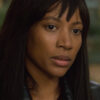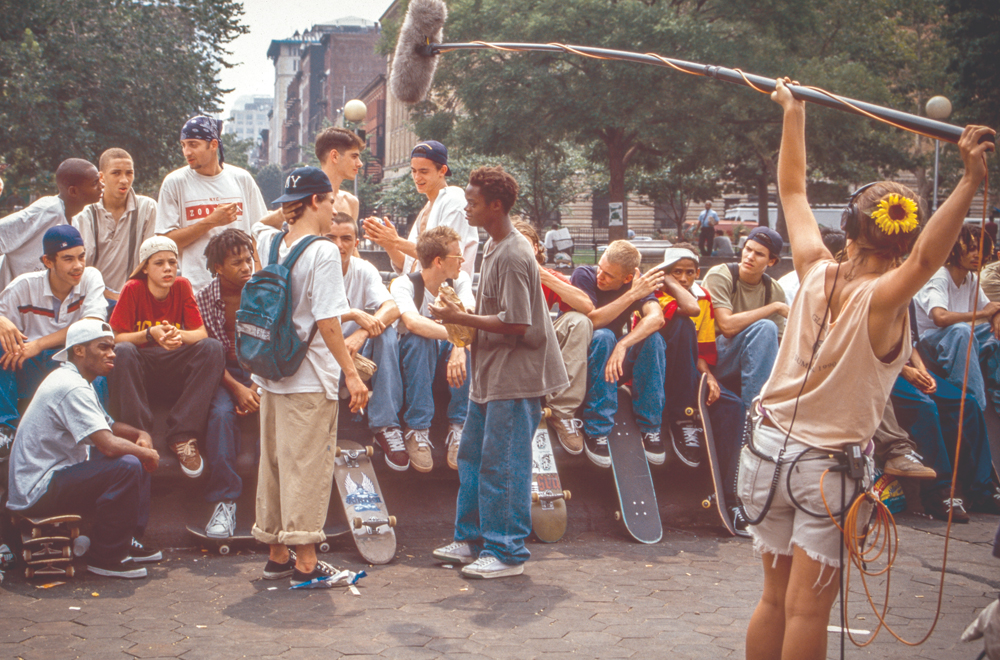In “The Kids,” Hamilton Harris recalls the surprise of coming into a casting call for “Kids” at the invitation of director Larry Clark and finding that his name was already in the script for the character he was supposed to audition for. Even without that clear indication he had the job, it wasn’t like the role of one of the skateboarders that hung out in Washington Square Park, memorably rolling up a blunt, could’ve have gone to anyone else since it was him – writer Harmony Korine has spent weeks hanging around Harris and the regulars at the park such as Ryan Hickey, Harold Hunter and Justin Pierce, coming up with a screenplay for Clark, a photographer celebrated for capturing youth culture, to make his feature filmmaking debut, but having to come in for a casting session made the fantasy of seeing himself on the big screen real for Harris while at the same time, becoming conscious that what the audience would see would not be.
It’s taken over two decades for Harris to reconcile what he lived through with what was portrayed in “Kids,” a incendiary drama full of underaged sex and drug use that sparked controversy that Harvey Weinstein made sure to capitalize on to its fullest and while it launched the careers of Clark, Korine, and stars Chloe Sevigny and Rosario Dawson, those that inspired it such as Harris felt left behind in its success, unsure of how to handle their newfound notoriety while wondering if they had been exploited as Clark encouraged behavior that was any parents’ worst nightmare on set and always ready to ply his cast with alcohol and “really good weed.” Rather than processing this alone, Harris generously began to reach out to those who shared the experience with him in the wake of the untimely deaths of Hunter and Pierce, and after feeling the crushing weight of the movie that Clark made and the images it would place in people’s minds, he and director Eddie Martin have beautifully taken back power for those who felt used and misrepresented by “Kids,” delivering a sobering history of the production and a fascinating and often moving consideration of cultural appropriation amongst a group that didn’t have the words for it yet.
In stark contrast to the narratively sensationalized yet aesthetically gritty “Kids,” “The Kids” presents its subjects with clear-eyed precision, allowed to hold the space they’re in as they recount the excitement of having anyone take an interest in them after growing up in the projects in New York and finding community when their own families typically offered little support, and ironically, after making a film in 1995 that was lauded for its ultrarealism, you can see for the first time those that participated in it in all their dimension, now grown adults who can look back on the film with the perspective of both time and maturity. As it turns out, there are not only surprises to be heard from the cast due to Clark’s determination to make the film he wanted to make irregardless of their actual experience, but unexpected detours when it comes to the lives they led and continue to, including the very making of the documentary, which Harris had carried on his shoulders for the past 12 years and finally saw its debut this week at the Tribeca Film Festival. With “The Kids” sparking conversation in New York and beyond – it’s still available to watch anywhere in the U.S. through June 23rd with Tribeca offering its lineup online – Harris spoke about the need for him toe reflect on the past and after having so much taken from him as a result of a film, creating one that he hopes will give something to others.
How did this come about?
I’ve been revisiting this for the last 12 years and really to process it and to heal from it, so yeah and it’s certainly in line with what’s going on globally, from how I see things. We are evolving as individuals in a collective and we are being more accountable for what we do and what we say, and what we project to people and to one another. I know that “Kids” had that effect 26 years ago and how it affected me and those that I shared that experience with, so I was hoping to share how I saw it and what I experienced and how I got through it. The going through process was some time and I’m showing it now, so it speaks for itself. There’s nothing else for me to say. I’ve said it all now. And now the question is what are you going to do about it? What is each of us going to do? Because I had to do my part.
I had to deal with the traumas of growing up, being born in the ‘70s, growing up in poverty, dealing with heroin epidemic and drug addiction within the home, AIDS and poor education. These things had a huge effect on me as a child and I’m taking that with me into my teenage years, using skateboarding as a coping mechanism. It’s a way of getting away before there was drugs, right? That was the drug and then finding skateboarding and finding your tribe and finding people who are sharing the same experiences and could relate to one another. It just so happens you’re at the right place at the right time and you become a part of something [with a movie] that you don’t know what it’s going to be. No kid is thinking this is going to be that, although I’ve heard something is going to happen and after a while as a kid, it’s like you’ve heard it too many times and you don’t see it, so it’s like “Whatever.” Focus on skateboarding. Then lo and behold, it’s happening and then what comes with that and the traumas that weren’t dealt with because there was no place to deal with it. There was no stable home to have those conversations.
The process of this film, and this was after Harold passed in 2006, [was figuring out] what needs to be told. Did I know it would take 12 years? I didn’t know, I didn’t care. I just knew that’s what it needed to be and however it gets there, when it gets there and it’s there, so I’ve done my part and I hope that people are able to take something from it.
What was it like figuring out the presence of Justin and Harold in this?
I had the right to tell it how I saw it, [because] everyone who’s alive right now, that’s your given right. You can tell your experience your way. For someone to silence you when they have a different experience, they have to figure that out. That’s self-projection and this process helped me learn that that doesn’t work. So I can’t say what someone has to do and I have to respect and understand people’s choices. That’s what I learned through this process. We touch on mental health and these kind of things, and we’re better equipped with dealing with that [now]. We didn’t have that back then and I’ll be 47 in july, and this is [me] 26 years ago. I’m dealing with my own mental health. [laughs] So think about Justin at 25? That’s so much pressure. I was 25 with him. Harold at 32… and Harold was the turning point or me.
I was facing these things already, going through my own healing process but that’s when it became clear that while going through this process, the process needs to be shared. And I was afraid – make no mistake. It took me a couple years to stop procrastinating because I was afraid to face it, but it just got to the point where I felt like the cat in the corner. There’s no way out and I wanted out. I don’t want to live in the corner no more. I wanted to be free and I jumped out the corner. It took 12 years, but it’s done now and I feel good and I hope those who I experienced with can find that closure.
You alleviated some of the burden on yourself when I know initially you were planning to direct, but you gave the reins to Eddie Martin. Did you have a lot of the groundwork covered?
With making this film, all the footage and stuff I knew where all this was, like the old archive, so as I’m seeing this in my head and I’m writing things down, I knew what I wanted to see. The catch was to get the intention and the emotion out, I didn’t have that skill — that’s where Eddie Martin comes in. He puts it all together. I had all these yellow notes on the wall, but he knew how to take all those yellow notes and if I explain it to you, you can feel it, you can see it, but I didn’t know how to turn me explaining it into a visual language, but he did. Together, we were able to come up with this work.
I read there were earlier iterations where Chloe Sevigny and Larry Clark were part of this, but it actually seems to the film’s benefit now that you kept it to the immediate circle of friends this started with. How did you narrow things down?
To be honest with you, a hundred people were interviewed and it’s 90 minutes, so it’s not possible. I learned this from Eddie Martin, who is a professional and a master at his craft. With that being said, I always made it inclusive, so I invited Larry and Harmony [Korine] and Chloe and Rosario [Dawson] and with their own free will, they chose not to partake in it for whatever reason. Do I have any hard feelings? Absolutely not. Because the flip side of it is when I was making this film, I knew that even if they were in the film, the essence of what you saw would still have to be there, and would things have shifted? Of course they would’ve shifted. You get other perspectives. But that essence that I knew needed to be told from the perspective of how I saw it had to be, just like how Larry told it his way [in “Kids”]. That’s how he saw it. He had every right to do it that way, and whether some things were true or false, that’s irrelevant. What’s relevant is that’s how he saw it and that’s how he wanted it, so he willed it that way. [Now] I’m willing it how I feel it and how I see it.
Were there things that you picked up from working on this that you may not have known at the time?
There were so many things I’ve seen and didn’t know about. There were so many turn of events that happened that I didn’t know about, and that just gave me closure. I was able to accept it. Like why try to change it? You get nothing from it. You get more from accepting it. You’re able to move on. You’re not stuck, you know? And for me, this was created with the intention not to be stuck because Justin and Harold were stuck. That’s why they made the action steps they made and the reality is they’re no longer here in the carbon world, right? Those of us who are here can make changes.
“The Kids” is available to stream through the Tribeca Film Festival until June 23rd.




